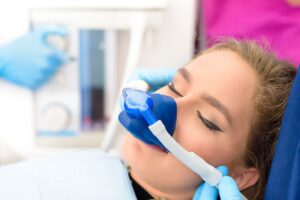Dental anxiety is a common occurrence in patients of all ages. But you can rest assured that your dentist will prioritize your comfort during every step of your dental treatment. Communicate your concerns with your dentist, and they will work with you to find dental solutions that fit your comfort levels while ensuring your smile stays healthy.
One way they can help patients feel relaxed in their care is with dental sedation. This medication differs from anesthetics, another tool used to maximize a patient’s comfort during a dental procedure.
When you know more about these options available to you, you can feel more at ease when you visit your dentist’s office. So read on to learn more about the differences between sedation dental treatment and anesthesia.

Local Anesthetics
A local anesthetic is a type of medication administered via injection in the mouth. The medicine blocks nerves in this targeted area of the mouth to numb you during the course of a dental procedure. The dentist will apply a topical anesthetic gel to that spot before the injection to make you even more comfortable.
Dentists will employ a local anesthetic during many dental treatments, including routine ones like dental fillings. This way, you will not feel any discomfort while you undergo necessary dental work.
The numb feeling will last for a few hours, so be careful when eating and drinking after you leave the dentist’s office. This medicine will not affect your level of consciousness, so you will stay aware and awake during the dental work. And you do not have to worry about it affecting and disrupting the rest of your day.
Sedation Dentistry
While anesthetics serve to numb the mouth and block pain during a dental procedure, sedation addresses dental anxiety directly. Dental sedation involves medicine that induces a calm sensation in a patient during the course of dental work. The degree of this calmness depends on the type of sedation.
Your dentist can offer you nitrous oxide, for instance, also known as laughing gas. You breathe in this medicine through a nasal mask prior to your dental work, and then you feel euphoric, light, and relaxed.
The sensation ends as soon as the dentist removes the mask and you breathe normally again. It will not affect your consciousness, and because the medicine wears off so quickly, you can return to your everyday schedule without issue.
The dentist can also provide you with an oral sedative. This involves taking a prescribed pill an hour before your dental appointment. It will make the patient feel calm and comfortable.
The medicine does make the patient feel groggy, and it can take several hours for the sedative to wear off. For this reason, you must arrange a ride to and from the dentist’s office.
General Anesthesia
General anesthesia is a type of medicine usually administered intravenously. It will make the patient unconscious during the course of dental work. The patient will return to awareness not long after the dentist stops the medicine, but they may feel disoriented for the rest of the day.
Dentists usually reserve general anesthesia for patients undergoing more extensive dental work, such as oral surgery, or patients with extreme levels of dental fear. Schedule a consultation with your dentist to learn more about sedation dentistry options.
